Catherine Morland stands out because she is so unlike Austen's other heroines. She looks to others for what's right or wrong. She fancies a respectable man to be a murderer. Obviously, Austen was younger when she wrote Catherine. This was one of her early attempts, so some tolerance can be granted. At least Catherine is still likable. She's fun, honest, open-minded. But reading her story is like reading a young woman's romance novel or a teenager's journal. That's not the worst thing in the world. But Jane Austen has fed us readers on filet mignon with her other novels. This one is like eating cotton candy. It's sweet as it goes down, but it soon disappears and is forgotten.
Of course, Austen may have been playing a joke on her readers. The whole novel may have been one big tongue-in-cheek joke on the Gothic romance genre: dark secrets, old houses (abbeys), dashing men. She just wrapped the joke up in a saccharin love story to make it more interesting. No doubt Austen herself was a perceptive woman with her own sense of humor. She makes fun of social classes in all her novels. Why not make fun of an entire genre in this one? In any case, readers are lucky Austen herself matured enough to write more solid female leads. Without them, Catherine would stand as Austen's lone heroine, and frankly, she couldn't take the heat.

1 comment:
I remember reading a forward, commentary whatever the first time I read this book that Austen's intentions were totally satiric. She was poking fun at the Gothic novels so prevalent at the time. I found this on Wikipedia.com (and we know that's always true): Northanger Abbey is fundamentally a parody of Gothic fiction. Austen turns the conventions of eighteenth-century novels on their head, by making her heroine a plain and undistinguished girl from a middle-class family, allowing the heroine to fall in love with the hero before he has a serious thought of her, and exposing the heroine's romantic fears and curiosities as groundless.
Post a Comment